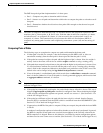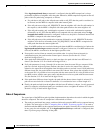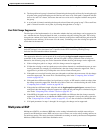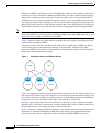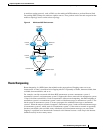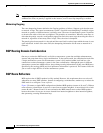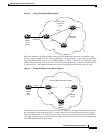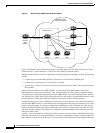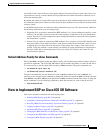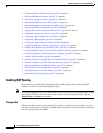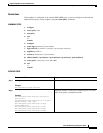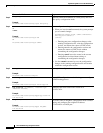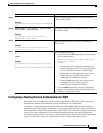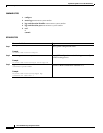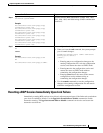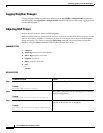
Implementing BGP on Cisco IOS XR Software
How to Implement BGP on Cisco IOS XR Software
RC-27
Cisco IOS XR Routing Configuration Guide
cluster ID so that a route reflector can recognize updates from route reflectors in the same cluster. All
route reflectors serving a cluster should be fully meshed and all of them should have identical sets of
client and nonclient peers.
By default, the clients of a route reflector are not required to be fully meshed and the routes from a client
are reflected to other clients. However, if the clients are fully meshed, the route reflector need not reflect
routes to clients.
As the iBGP learned routes are reflected, routing information may loop. The route reflector model has
the following mechanisms to avoid routing loops:
• Originator ID is an optional, nontransitive BGP attribute. It is a 4-byte attributed created by a route
reflector. The attribute carries the router ID of the originator of the route in the local autonomous
system. Therefore, if a misconfiguration causes routing information to come back to the originator,
the information is ignored.
• Cluster-list is an optional, nontransitive BGP attribute. It is a sequence of cluster IDs that the route
has passed. When a route reflector reflects a route from its clients to nonclient peers, and vice versa,
it appends the local cluster ID to the cluster-list. If the cluster-list is empty, a new cluster-list is
created. Using this attribute, a route reflector can identify if routing information is looped back to
the same cluster due to misconfiguration. If the local cluster ID is found in the cluster-list, the
advertisement is ignored.
Default Address Family for show Commands
Most of the show commands require the address family (afi) and subsequent address family (safi) to be
specified as arguments. The Cisco IOS XR software parser provides the ability to set the afi and safi so
it is not necessary to specify them while executing a show command. The parser commands are:
• set default-afi {ipv4 | ipv6 | all}
• set default-safi {unicast | multicast | all}
The parser automatically sets the default afi value to ipv4 and default safi value to unicast. It is
necessary to use only the parser commands to change the default afi value from ipv4 or default safi value
from unicast. Any afi or safi keyword specified in a show command overrides the values set using the
parser commands. Use the following command to check the currently set value of the afi and safi:
• show default-afi-safi
How to Implement BGP on Cisco IOS XR Software
This section contains instructions for the following tasks:
• Enabling BGP Routing, page RC-28 (required)
• Configuring a Routing Domain Confederation for BGP, page RC-31 (optional)
• Resetting eBGP Session Immediately Upon Link Failure, page RC-33 (optional)
• Logging Neighbor Changes, page RC-34 (optional)
• Adjusting BGP Timers, page RC-34 (optional)
• Changing the BGP Default Local Preference Value, page RC-35 (optional)
• Configuring the MED Metric for BGP, page RC-36 (optional)
• Configuring BGP Weights, page RC-38 (optional)



